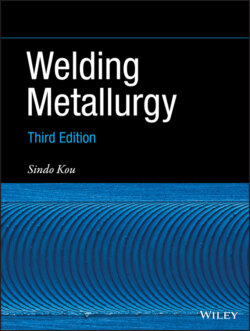Читать книгу Welding Metallurgy - Sindo Kou - Страница 93
3.2.2 Gas−Metal Arc Welding
ОглавлениеMurphy [9–13] studied the effect of metal evaporation on gas−metal arc welding (GMAW) of Al alloys. In GMAW significant evaporation of metal elements can occur at the tip of the filler metal, which will be called the wire here for simplicity. The wire is usually positive in polarity, and the electrons enters the melted wire tip and release much energy equivalent to the work function (Section 1.3.2.2). At the anode spot at the melted wire tip, the boiling point of the wire material is achieved. The concentration of metal vapor in the arc can become as high as 50% [10–12].
Figure 3.11 shows in GMAW lap welding the arc temperature and Al‐vapor distributions in a vertical plane through the Al wire electrode and normal to the workpiece [13]. At the anode spot much Al is evaporated and carried downward as an Al‐rich (>50% Al) stream to the weld pool. According to Murphy [11], the presence of aluminum vapor strongly decreases the arc temperature. For instance, the maximum temperature can be 9800 K in the presence of Al vapor and 14 000 K without it. This is due to the strong stream of vapor (80 m/s speed), which is driven mainly by the magnetic pinch force and the evaporation of vapor from the wire tip. Murphy [11] also showed that the radiative emission coefficient is higher for metal vapor than for argon. It was therefore concluded that two factors contribute to the decrease in arc temperature that occurs when metal vapor is present. One is the increased heat loss caused by radiative emission of the vapor to the surroundings and the other is the stream of relatively cold metal vapor from the melted wire electrode tip.
Figure 3.11 Calculated temperature and Al distributions in lap welding of Al by GMAW: (a) temperature; (b) Al vapor in mass fraction.
Source: Murphy et al. [13]. © Elsevier.
Figure 3.12 shows that a calculated Al weld made by GMAW can be significantly too deep if the presence of the Al vapor in the arc is neglected. According to Murphy [11], since the plasma temperature is reduced by the presence of Al vapor, the thermal conduction from the arc to the workpiece is reduced (e.g. 610−470 W for the parameters investigated). This is because thermal conduction from a warmer region to a cooler one is proportional to the temperature difference between the two regions.
Figure 3.12 Comparison of measured weld cross‐section with those calculated including and neglecting the influence of aluminum vapor.
Source: Murphy et al. [13]. © Elsevier.
Although the total power generated in the arc (electric current × arc voltage, e.g. 855 W) is not affected by the presence of Al vapor in the arc, its distribution is affected. Al vapor increases the electrical conductivity of the arc plasma at low temperatures. This means electric current can now also be conducted through the outer cooler portion of the arc. Since a larger horizontal cross‐section of the plasma can conduct the electric current, the current density is reduced, so is the heat flux density.
